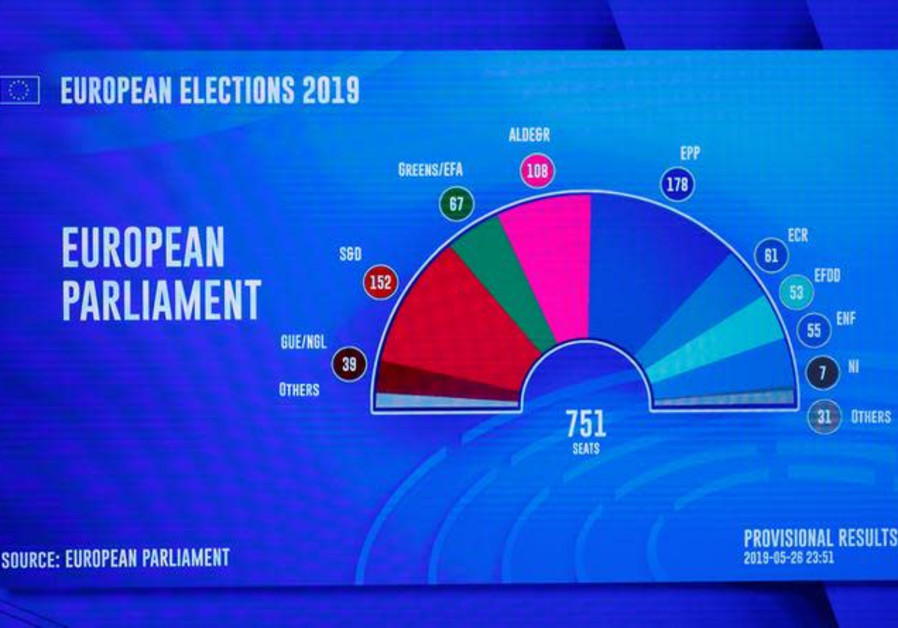Europe’s consensus slides again in EU elections

A projection of the composition of the next European Parliament is seen on a screen during of the final estimation of the results of the European Parliament election in Brussels. (photo credit: REUTERS/FRANCOIS LENOIR)
European Parliament elections continued to illustrate the breakdown of traditional politics that dominated the continent for decades. The alliance of Socialists and Democrats lost 20% of its seats while the European People’s Party, which is based on the old Christian Democratic parties of European countries, also lost around 20% of its seats as well.
The two center-left and center-right parties now have only 43% of the votes in the 751-seat parliament. The parliament is supposed to represent more than 500 million people in 28 countries. The United Kingdom, which was supposed to leave the EU in March, participated in the elections after postponing its departure.
The elections across Europe were supposed to signal yet another rise of populists, nationalists and the far-left. On the eve of the elections Guy Verhofstadt, head of the ALDE group of Liberals and Democrats, said that if populism wins, Europe will “die from inside.” Verhofstadt is the Prime Minister of Belgium as well as leading the block of liberals. The ALDE appears to have gained more than 100 seats, compared to its 59 in 2014. Some of the vote counts depend on the math employed and groups included.For instance Europe Elects, a site that tracks the votes, says ALDE was projected to get 115 seats, if one includes French President Emanuel Macron’s Renaissance group. The European Parliament website says the ALDE actually got 107 as of Monday morning.
If the liberals were a winner on election night, so were the Greens who are estimated to have gained 25 seats from 50 to 75. The nationalist Europe of Nations and Freedom party had a mixed night. The right-wing group contains Marine Le Pen’s National Rally, the Freedom Party in Austria, Flemish nationalists in Belgium and the Northern League in Italy, among others. Italy’s Deputy Prime Minister Matteo Salvini said that “Europe is changing” as his party performed well in Italy. Le Pen also did well in France, cementing the the Franco-Italian turn to the right.
Overall the night wasn’t a sweep for populists and the far-right as some had feared. In fact, the right in Europe suffers from being fractured between too many groups. It has its Conservatives and Reformists, its People’s Party, it’s Europe of Nations and Freedom and its Europe of Freedom and Direct Democracy, the latter a Euro-skeptic party that was galvanized around the UK’s support for Brexit. This time the UK has once against sent Nigel Farage to Europe as head of his Brexit Party. His former UKIP party performed badly.
But what do the elections really tell us? In many countries the far-right receives between ten and 30% of the vote. But so does the far-left, leaving the center squeezed. Overall this is the trend in Europe since the end of the Cold War. The consensus has been eroding for two generations. It’s not surprising, since the EU doesn’t seem to be delivering these generations the jobs and security they want. From security threats that make some European cities look like armed camps to inability to deal with immigration, the EU has not provided answers. Its leaders, like Jean-Claude Juncker, are embarrassing. He contented himself on the eve of elections by calling nationalists “stupid.”
The map after the elections points to Spain, Portugal and Norway being more left-leaning while Italy and France are more right leaning. Central and Eastern Europe largely vote for the center-right and right while northern Europe has more liberals. The Greens broadly do well in the wealthier countries such as Germany, France, Spain and the UK, as well as Sweden.
With the final counts being done, there will still be some horse trading in the parliament as some of the parties and blocks change. But the divided politics of Europe hasn’t changed. Eroding the center doesn’t bring together the extremes. It only makes for more and more parties. The prophets of populism and nationalism did not complete the takeover of Europe they have predicted for the last decades.
Join Jerusalem Post Premium Plus now for just $5 and upgrade your experience with an ads-free website and exclusive content. Click here>>






Comments are closed.